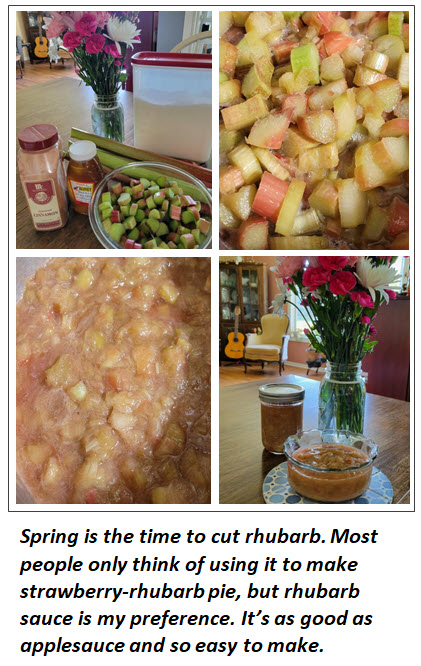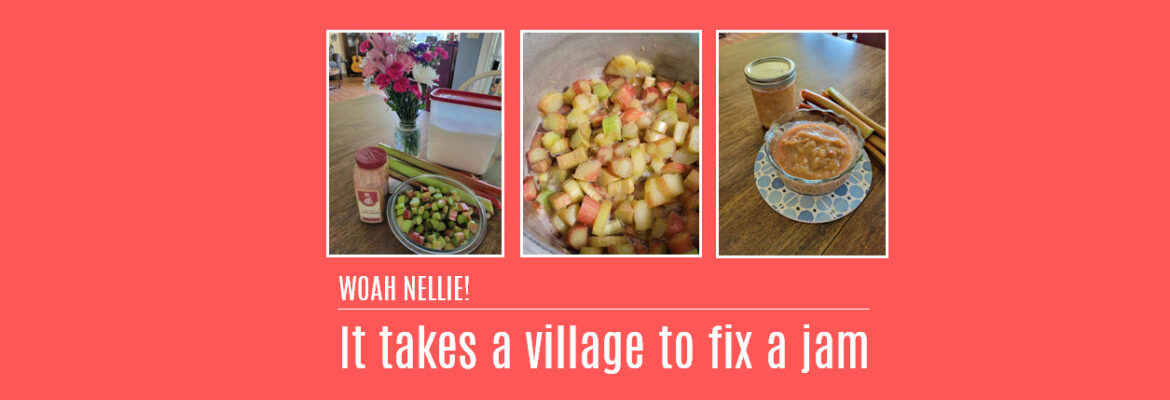Woah Nellie!
It takes a village to fix a jam
by Mary Jo David
If you read the headline and assumed this month you’d be following along making a 100-year-old jam recipe from Nellie Maxwell, you’d be—wrong!
This month, I was at the mercy of my desk drawer, which was “jammed” shut. It’s the desk drawer where I store my thumb drive that holds all the old Stockbridge Brief-Sun editions. You know what that means: 1) When I finally get it open, it’s time to clean out that drawer, and 2) I have an excuse to veer from testing a 100-year-old Nellie Maxwell recipe and try something different this month.
Truth be told, I could have visited the Stockbridge Library to access the vintage Brief-Sun editions on their thumb drives. But I really wanted to write about rhubarb this month, and I wasn’t confident I’d find a rhubarb recipe in Nellie’s June 1924 columns.
In trying to keep with the theme of this column, though, I’m using very old rhubarb. Or to be more specific, my rhubarb plants were thinned from rhubarb plants that likely had their start 70-plus years ago.
And it really does take a village. By that I mean, my two rhubarb plants were gifted to me by Stockbridge’s Patrice Johnson—the founding editor-in-chief of the Stockbridge Community News. Patrice’s rhubarb plants were originally from plants her mother, Willah Weddon, grew. According to Patrice, the original plant was at least 65 years old.
I never had the pleasure of meeting Willah, but from everything I’ve heard, she flourished as a writer, wife, and mother. Not surprising then, that from the moment I was gifted those rhubarb plants, they just took off growing. Every year since, I’ve had a bountiful harvest from each plant. I feel very fortunate to have my plants because, according to HighAltitudeRhubarb.com, the U.S. has only about 1,300 acres devoted to rhubarb production. That’s not a lot!
Spring is the time to cut rhubarb. While most people only think of using it to make strawberry-rhubarb pie, rhubarb sauce is my preference. It’s as good as applesauce, and last year I discovered it’s a great addition when making a trifle for dessert.
Rhubarb sauce is so easy to make. The plant leaves are toxic, so make sure to cook only the stems, chopping them into about one-half-inch pieces. In a heavy saucepan over medium heat, mix together 6 cups of chopped rhubarb, 1/2 cup of granulated sugar, and 3 tablespoons of water. In about 20 minutes, your rhubarb should soften to the texture of applesauce. As it begins to soften, add about 1/8 teaspoon (or to taste) of cinnamon, or leave the cinnamon out if you prefer. Continue to stir and mash the rhubarb mixture until it is the desired consistency. Use an immersion blender, if you have one, to get the consistency you prefer.
Alternatives: At our house, we prefer the rhubarb to retain some of its tartness. But if you like a sweeter sauce, many recipes call for up to 1 cup of sugar. Also if you enjoy the pairing of rhubarb and strawberry, by all means add some fresh strawberries to the chopped rhubarb before cooking. It is very hard to mess up rhubarb sauce! I’ve also used half sugar and half honey from another local friend’s hives. And when I ran out of that, I used honey from the Stockbridge Open-Air Market. (See what I mean, it does take a village.)
This month’s recipe received an A-plus from my resident taste-tester. I might add that he looked a little too relieved that I had veered away from making a Nellie recipe this month. He was more than happy to taste-test the rhubarb sauce. After all, I learned how to make it from his grandmother.

Also within our “village” of neighbors and friends, we were the lucky recipients of some home-grown asparagus from our friend and longtime Gregory resident Al. He has opened our eyes to how good asparagus is right after it’s cut. To make the most of this asparagus, I made a simple and delicious Asparagus Soup with Lemon and Parmesan that I found online at OnceUponAChef.com.

